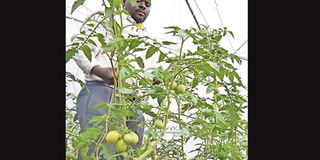Agronomist notebook: Hey, don’t invest in tomatoes because of the current high prices

A teacher at Lunza Primary School in Kakamega harvests tomatoes in a greenhouse in the school. The main reason why prices of tomatoes have risen significantly is disease infestation during the last quarter of the year 2019, following heavy rains. PHOTO | FILE | NATION MEDIA GROUP
What you need to know:
- Before planting tomatoes, you need to know why the prices escalated in the first place to avoid making mistakes that others have done by rushing to plant certain crops.
- Tomatoes do well in cool and dry places. However, heavy rainfall experienced between October 2019 and January 2020 saw the bulk of tomatoes being affected by diseases, in particular early and late blight.
- Having known why prices are currently high, let us do the math. Tomatoes take about a month in the nursery after sowing, before transplanting takes place.
- At transplanting, ensure you dip the seedlings in a protective chemical such as copper to make sure that they seedlings are protected from the fungal diseases.
Tomato prices have surged to an all-time high of Sh50 for three pieces in some places due to a shortage caused by last season’s rains, which destroyed the crop.
Thus, with a few growers, especially those who cultivate the crop in greenhouses, reaping big, some opportunistic farmers are thinking of farming tomatoes, expecting to earn more when they harvest.
Well, think twice because luck does not strike twice, especially in the case of farm produce whose prices are determined by market fluctuations and even the weather.
Before planting tomatoes, you need to know why the prices escalated in the first place to avoid making mistakes that others have done by rushing to plant certain crops.
The main reason prices of tomatoes have risen significantly is disease infestation during the last quarter of the year 2019, following heavy rains.
Tomatoes do well in cool and dry places. However, heavy rainfall experienced between October 2019 and January 2020 saw the bulk of tomatoes being affected by diseases, in particular early and late blight.
A number of tomato fields were also swept away by the floods or storm water, resulting in huge losses for farmers. This, therefore, led to a shortage in the market.
Having known why prices are currently high, let us do the math. Tomatoes take about a month in the nursery after sowing, before transplanting takes place.
This means if you sow them now, you are most likely to start harvesting in May or June, if all factors remain constant.
Most likely, prices of the produce will have gone down in May or June due to high supply in the market.
To avoid making losses, you can secure a ready market before considering planting the tomatoes by visiting institutions such as schools and restaurants and signing contracts with them.
SCOUT FOR PESTS AND DISEASES EVERY DAY
But again, with the rains remaining erratic, you cannot be sure that your tomatoes will do well even if you sign a contract.
All said, ensure the seeds you plant are certified and resistant to the viral diseases and blight. This will minimise chances of disease infestation since, in farming, as in many other sectors, prevention is better than cure.
Raise your own seedlings to reduce the cost of production and be guaranteed of healthy and vigorous plants.
Starting with a quality plant also helps the crop grow strong and less susceptible to diseases. In the nursery, protect seedlings against fungal diseases using copper-based chemicals.
At transplanting, ensure you dip the seedlings in a protective chemical such as copper to make sure that they seedlings are protected from the fungal diseases.
If you are planting the tomatoes in areas that are prone to erosion, ensure that you have a good drainage system on your farm to protect the farm from flooding.
Erect windbreakers on the border of the farm to prevent the spread of diseases due to wind. You can use a shade net or plant crops such as maize as a border crop.
Pruning should be done at the right time, not when it’s too humid, as this encourages the spread of fungal diseases.
Pruning tomatoes is a good practice since it encourages aeration of the plant and prevents the spread of diseases.
While pruning, disinfect the clipper after using it on every crop to prevent the spread of the diseases. Also, start from unaffected areas to affected ones to curb diseases.
As a good practice, always scout for diseases and pests every day, that is, early in the morning or late in the evening.





